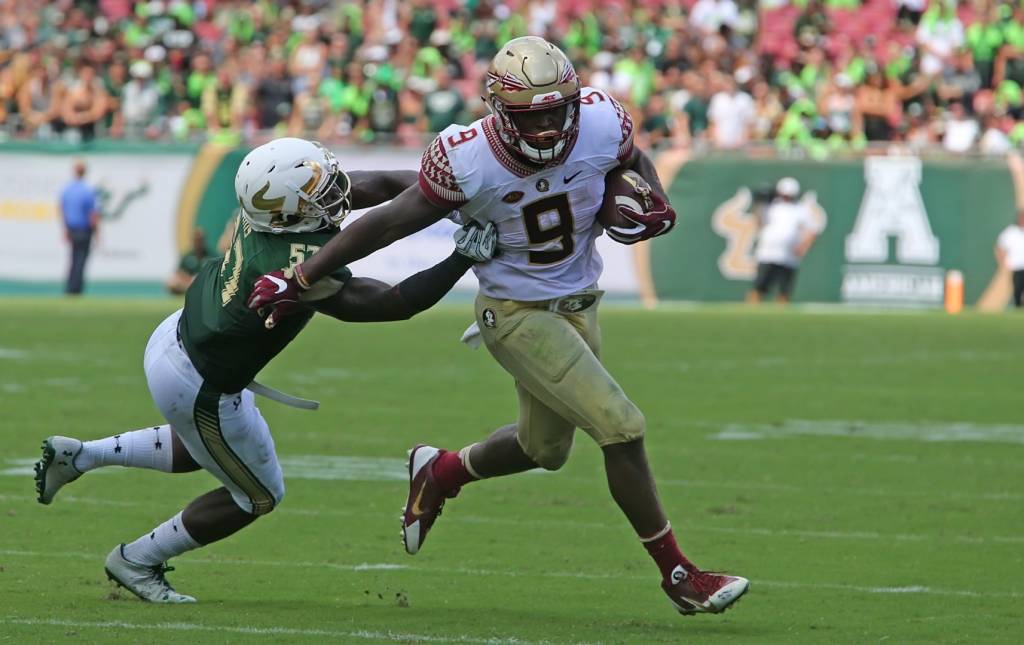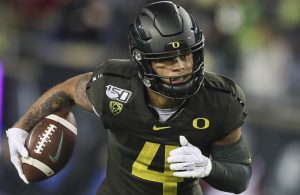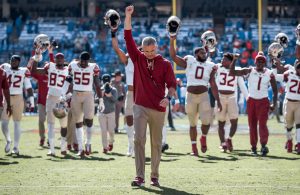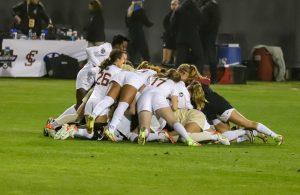- Sunday Seminole Summary: FSU Football Adds Pair of WR Transfers
- Sunday Seminole Summary: FSU Football Exits ESD With Top-15 Class
- Sunday Seminole Summary: FSU Soccer Tops BYU for Third National Championship
- Sunday Seminole Summary: FSU Soccer Advances to National Championship Match
- Seminole Sunday Summary: FSU Soccer Heads Back to College Cup
- Seminole Sunday Summary: FSU Soccer Reaches Sweet 16; Football Tops Boston College
- Seminole Sunday Summary: FSU Soccer Wins ACC, Advances to Second Round of NCAA Tournament; FSU Football Rallies Past Miami
- Seminole Sunday Summary: FSU Soccer Tops Wake on OT to Advance to ACC Final
- Seminole Sunday Summary: FSU Football Crushes UMass for Third Straight Win
- Seminole Sunday Summary: FSU Soccer Stays Perfect with Pair of Wins
FSU Football: Running Back By Committee Still the Favorite
- By Clint Eiland
- Updated: August 3, 2017
 Damon Herota/FSU athletics
Damon Herota/FSU athleticsThe Florida State football team returned to the practice fields on Tuesday for the beginning of fall camp. With the season opener against Alabama just under a month away, fans are dying to know which players look like they’re going to make an immediate impact. The known quantities like quarterback Deondre Francois or cornerback Tarvarus McFadden are pretty easy to project.
Other areas are more difficult. Perhaps the most pressing question for the offense revolves around the running back position. With Dalvin Cook off to the NFL, the Seminoles have to figure out how to replace his stellar production from the backfield. Who will emerge as the starter? The talent is obviously there.
Returning contributor Jacques Patrick has combined for over 700 yards and nine touchdowns as Cook’s backup, and head coach Jimbo Fisher stated in yesterday’s press conference that Patrick has earned the starting job. He even denied that there would be a running back by committee.
Behind Patrick are a group of high potential freshman. Cam Akers, Khalan Laborn, and Zaquandre White were all highly-regarded recruits for the 2017 class. Akers has all the hype behind him, recently being named as a top 100 player by Sports Illustrated despite never taking a college snap. Will Cam Akers eventually start? Despite what Fisher stated?
That answer is a bit trickier to project. It’s likely that Patrick will get the first carries early in the season. Though someone like Akers is bound to get more reps as the season progresses. If it turns out that Akers provides more at the “starting” spot, then Fisher will absolutely place him there.
Here’s what is abundantly clear going into the season: despite what Fisher said, there is almost certainly going to be a running back by committee.
One only has to look at his past offenses to realize that Fisher loves to utilize different skill sets. Patrick is a bruiser that is getting more comfortable with his physical gifts. Akers has burst that can’t be taught. Laborn has versatility that makes him a weapon in the passing game. This group of players is almost perfect for the FSU offense.
So how has this actually played out in prior years?
We examined the rushing attempt numbers from 2010-16. A player must have been a running back or fullback and had at least 10 attempts that year. We divided an individual’s attempts from the total and came out with the percentage of all rush attempts they had for that year.
The full splits exemplify what some may have already guessed from the title. Florida State loves to use multiple running backs and 2017 projects to be no different.
In 2010, the eligible players were Chris Thompson (41%), Ty Jones (26%), Jermaine Thomas (26%), and Lonnie Pryor (7%). Both Jones and Thomas received more than 80 attempts on the season despite Thompson being the clear No. 1 back. They even combined for over 1,000 yards rushing and 11 touchdowns.
2011 is an odd story. It’s the least amount of rushing attempts by the running backs so far with only 295 from the group. The second lowest was 2010, who tallied 330. It’s also affected by Chris Thompson sustaining an injury in the fifth game of the season, necessitating other backs to step up.
In the end, it equaled out to Devonta Freeman (41%), Jermaine Thomas (20%), James Wilder Jr. (12%), Thompson (10%), Lonnie Pryor (9%), and Ty Jones (8%). Freeman received the most carries by far with 120, but behind him it was a rotating stable. Not surprisingly, injuries all over the offense meant 2011 was a down year on that side of the ball.
2012 had the most total attempts of any year listed (388 rushes). It also had the most parity. Freeman and Wilder both received around 29 percent of the carries, with Chris Thompson right behind them at 23 percent before his injury. Pryor added 12 percent and Debrale Smiley cleaned up with 7 percent. It was a true juggernaut of a backfield and it helped catapult the rushing offense to fifth in the S&P ratings. Three different players had over 600 yards rushing. That’s excellent production.
Even with Jameis Winston at the helm in 2013, rushing did not take a backseat. Fisher pounded the ball 378 times with the main backs, which included entrenched starter Freeman (46%), Karlos Williams (24%), Wilder (21%), and Ryan Green (9%). This was yet another year where three different backs amassed over 500 yards on the ground, despite split carries.
2014 is where a bit of a shift begins. As Dalvin Cook enters the program and continues to shine, he becomes the absolute workhorse of the offense. Williams was supposed to be a capable starter for 2014, but he had issues early on and Fisher decided to insert Cook to jumpstart the ground game. Hence why Cook accounted for 47 percent and Williams for 42 percent. There was only one other back that got more than 10 reps — Mario Pender, who was 11 percent of rushing totals that year.
Starting in 2015, Cook becomes the unquestioned starter. He receives 66 percent of all attempts and subsequently garners over 1,600 yards and 19 touchdowns. Behind him in mop-up duty is Jacques Patrick with 18 percent, yet he only puts up 314 yards for the season. Pender and Johnathan Vickers get 9 and 7 percent, respectively, but they barely crack 100 yards.
Which brings us to 2016. Cook received an incredible 77 percent of rushing attempts. Patrick finished with 16 percent, while Freddie Stevenson and Ryan Green both had about 3 percent. Did it work? Certainly, considering the offense finished near the top of multiple metrics. But did it work because of the system, or did it work because Cook really was that good?
The answer is probably the latter. Cook’s numbers in 2015 and 2016 are clearly unusual when taken in context of other Fisher offenses. The Seminoles have loaded up on talent in the backfield, but players like Cook simply don’t come around often.
Anyone expecting one back to absolute dominate the carries this year will probably be shocked at what they see. History shows that even with established starters like Thompson in 2010, Freeman in 2012-13, and Williams in 2014, the ball is going to be distributed to multiple players.
It’s also clear that the depth at running back is much better than it was in 2015 and 2016. Incidents like Mario Pender getting kicked off and Ryan Green getting injured forced the team to work around the light reserves. At least now the Seminoles have more than two capable backs.
If one had to wager how that’ll play out in 2017, it’d probably look something like this: Cam Akers (40%), Jacques Patrick (35%), Khalan Laborn (10%), and then a mix of Zaquandre White/Amir Rasul/Ryan Green. The offense simply works better when it has more options to play with.
Don’t buy the coach speak. Fisher knows what he has under his sleeve.




You must be logged in to post a comment Login